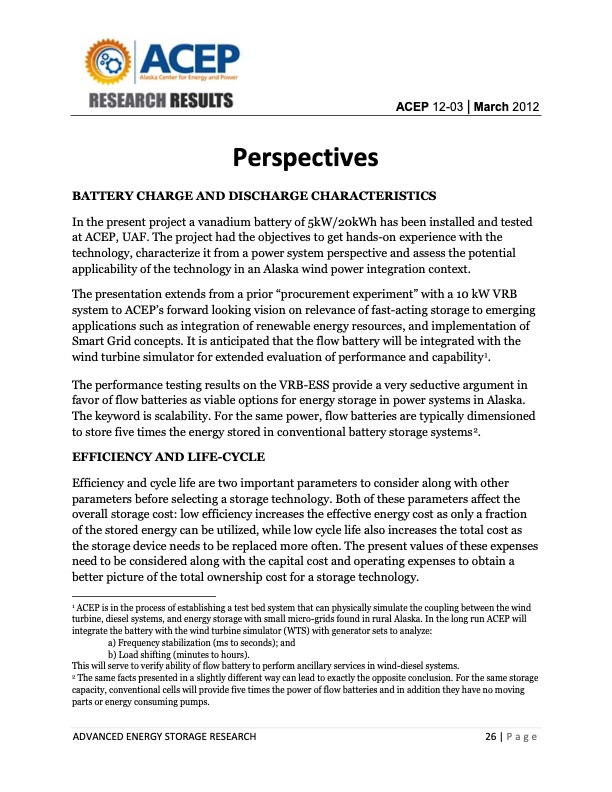
PDF Publication Title:
Text from PDF Page: 039
ACEP 12-03 | March 2012 Perspectives BATTERY CHARGE AND DISCHARGE CHARACTERISTICS In the present project a vanadium battery of 5kW/20kWh has been installed and tested at ACEP, UAF. The project had the objectives to get hands-on experience with the technology, characterize it from a power system perspective and assess the potential applicability of the technology in an Alaska wind power integration context. The presentation extends from a prior “procurement experiment” with a 10 kW VRB system to ACEP’s forward looking vision on relevance of fast-acting storage to emerging applications such as integration of renewable energy resources, and implementation of Smart Grid concepts. It is anticipated that the flow battery will be integrated with the wind turbine simulator for extended evaluation of performance and capability1. The performance testing results on the VRB-ESS provide a very seductive argument in favor of flow batteries as viable options for energy storage in power systems in Alaska. The keyword is scalability. For the same power, flow batteries are typically dimensioned to store five times the energy stored in conventional battery storage systems2. EFFICIENCY AND LIFE-CYCLE Efficiency and cycle life are two important parameters to consider along with other parameters before selecting a storage technology. Both of these parameters affect the overall storage cost: low efficiency increases the effective energy cost as only a fraction of the stored energy can be utilized, while low cycle life also increases the total cost as the storage device needs to be replaced more often. The present values of these expenses need to be considered along with the capital cost and operating expenses to obtain a better picture of the total ownership cost for a storage technology. 1 ACEP is in the process of establishing a test bed system that can physically simulate the coupling between the wind turbine, diesel systems, and energy storage with small micro-grids found in rural Alaska. In the long run ACEP will integrate the battery with the wind turbine simulator (WTS) with generator sets to analyze: a) Frequency stabilization (ms to seconds); and b) Load shifting (minutes to hours). This will serve to verify ability of flow battery to perform ancillary services in wind-diesel systems. 2 The same facts presented in a slightly different way can lead to exactly the opposite conclusion. For the same storage capacity, conventional cells will provide five times the power of flow batteries and in addition they have no moving parts or energy consuming pumps. ADVANCED ENERGY STORAGE RESEARCH 26 | P a g ePDF Image | Advanced Battery Storage Systems Testing at ACEP VRB ESS

PDF Search Title:
Advanced Battery Storage Systems Testing at ACEP VRB ESSOriginal File Name Searched:
ACEP-VRB-Testing-Report.pdfDIY PDF Search: Google It | Yahoo | Bing
Salgenx Redox Flow Battery Technology: Salt water flow battery technology with low cost and great energy density that can be used for power storage and thermal storage. Let us de-risk your production using our license. Our aqueous flow battery is less cost than Tesla Megapack and available faster. Redox flow battery. No membrane needed like with Vanadium, or Bromine. Salgenx flow battery
| CONTACT TEL: 608-238-6001 Email: greg@salgenx.com | RSS | AMP |